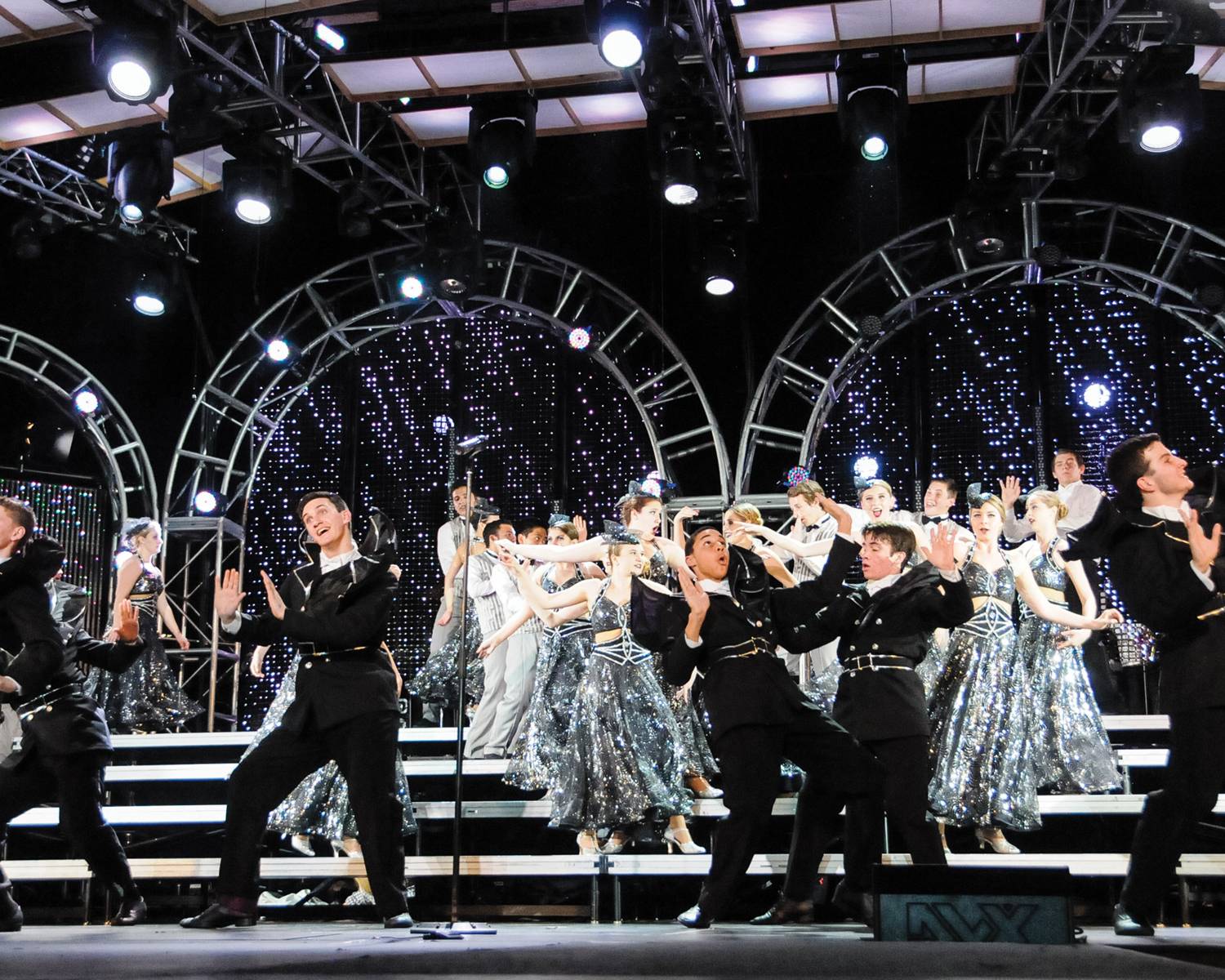
The centerpiece of the program, the show choir Powerhouse, has appeared on “Dancing with the Stars,” “The Oprah Winfrey Show,”and “The Voice”-all in the last five years. In addition to traveling to Hong Kong and China, they have won several championships at Showstoppers competitions and FAME Events; they have won the FAME Events Show Choir Cup twice.
The Power of Community: “Inspiration, Education, and Laughter”
Linda Cable, the co-president of the John Burroughs VMA, explains that the “success of this organization rests on the shoulders of many.” She suggests the strengths of their VMA can be summed up in three words: “inspiration, education, and laughter.”
Cable adds that because both Brendan Jennings, the Music Director, and Jen Oundjian, the Creative Director, attended John Burroughs high school, they have a special connection to the group and always will, since the group’s leaders “performed on the very stage where they now teach and inspire students to continually reach higher.”
In addition to having an incredibly devoted staff and association members, including community members, teachers, and administrators, the VMA is also filled with others that have long-term connections to John Burroughs. Cable adds that many “long-standing, talented individuals-including musicians, choreographers, and crew” are all graduates of Burroughs, so “it’s really this sense of legacy that makes our program what it is, or rather what it has become.”
Student Juliana Lyons moved to California two years ago, and she experienced the open and welcoming nature of this powerful community immediately. She notes that, like all teens, she was nervous about the move; she was even more upset to learn that she had missed the choir audition by months. To her surprise, she was allowed a late audition and was placed in an advanced choir just two days before the season started. For her, this opportunity was more than just a chance to perform. Participating with the VMA gave her a “great group of friends,” and she adds, “I don’t think I would enjoy high school if it weren’t for choir.” Now, Juliana is in her third year with the group, and she is the president of the vocal ensemble.
Cable believes their sense of community is best shown through the shows hosted by the VMA each year, including the Burroughs on Broadway show, a “full production that showcases the vocal and dance talents” of their students, in addition to functioning as a fundraising event. Student John Cutone, who serves as the vice president of the vocal ensemble, also praises Burroughs on Broadway for “adding another aspect of musical theatre” to make them “wellrounded performers and not just show choir kids.”
Cutone suggests that Powerhouse is also unique in their classical influence. He explains that every year they have a classical festival, By Rachel James Clevenger Photos provided by Susy Shearer Photography photo courtesy of Sus Shearer Photography where students have the opportunity to study several classical pieces. Cutone believes that singing a variety of styles helps to “mature” their sound, as well as offering Powerhouse a “distinct, big, signature sound” that sets them apart from other choirs.
Brendan Jennings and “Beautiful Imperfection”
Parent Stacy Adams praises Jennings for putting together a “fabulous program of topnotch people.” She also applauds his ability to delegate responsibilities and oversee everything without micromanaging because he “knows it’s in trusted hands.”
Additionally, Adams is often touched by the way Jennings ties in his experiences as a student to connect with the choir members in a deep and meaningful way. She explains that Jennings has shared what being part of the program meant to him while he was in high school, and she wonders if even Jennings realizes “what an impact he’s had on these kids’ lives.”
Though his training and talent are outstanding, Adams also praises his personality as a leader, in that he is easygoing, approachable, and funny. Adams appreciates how Jennings keeps people involved in the program, whether it’s the former show choir director who returns to offer vocal assistance or a middle school director who works for a feeder school. Adams adds, “As a parent, you just believe in the program.”
For Jennings, he explains, “I’m teaching my students how to be excellent” (in general). He knows that many of his students won’t go into music, so he wants them to “get a sense of what it’s like to work really hard and be the best at something.” He also wants them to focus on doing “everything really well” and being their best “no matter what the stakes are.” However, Jennings is not about perfection.
Instead, the style at John Burroughs is more focused on this mantra: “Give all of yourself emotionally to the music and the choreography.” In fact, Jennings believes the most striking moments are when “everyone is really into it,” which means they may be letting go of “tiny, technical details.” He concludes, “Beautiful imperfection is more the goal.”
Sharing the Spotlight: Jen Oundjian — A Creative, Driving Force
Parent Stacy Adams says of Jennings, “He never needs the spotlight on him-it’s always about the kids.” Not surprisingly, Jennings was quick to shift the focus from himself to his long-time partner and creative director Jen Oundjian; Jennings stated that, stylistically, he is “not the best reflection of what goes on at Burroughs.”
Jennings calls Jen Oundjian the “creative driving force” behind Burroughs. In fact, the only praise he accepts really is that he’s good “at helping Jen make her visions come true.” Jennings also says, of their partnership, that they “strive to not stay inside of one box” and every year aim to do something “completely different.” Jennings adds, “You can creatively push the boundaries in whatever way you want to go, and you should have the courage to go those places.”
When they first met, Brendan was Jen’s student; the director of the program at that time-Mary Rago-and Jen started grooming Brendan, while he was still in college, to take over the John Burroughs VMA. Because Mary had built an entire program, Jen knew that Brendan taking over was a “big leap.” She even stepped away from the program for six months, so Brendan had the freedom to “be the director that he needed to be” and to let him get comfortable in his own space and in this new leadership role.
Not only did his calmness ease the transition, as well the meticulous nature of the planning that went into making this a smooth transition, but Oundjian also notes that the kids that year were “so helpful and accommodating.” They recognized that the adjustments would lead to a stressful period, despite all the careful planning, and the seniors (in particular) made sure that the choir members’ attitudes would always be helpful and supportive.
He’s “very, very trusting,” Oundjian shares; in fact, she adds, “Rarely does he question anything.” Oundjian praises Jennings for being logical, grounded, and even-tempered, which she believes offers a perfect balance for her “visions and ideas.” She notes that her “crazy, whacked-out, emotional” approach meshes with his methodical, logical approach-pitting her “craziness.and out-there-ness.and extremes” against his “calm, collected, compartmentalized brain.”
Stacy Adams says of Jen’s pieces, “As a parent, you hear it first from your kid. They might not even know how to explain it.” Then, in the audience-after the “Alice in Wonderland” set, for instance-you see the audience not knowing how to respond: “What did we just see? Do we clap here?”
Of Oundjian, student Juliana Lyons notes, “She is one of the most creative people I’ve ever worked with.” Though Lyons calls Jen “wildly creative and ingenious,” she does admit that Oundjian’s ideas are always-initially-a little jarring, and even shocking. She said the typical reaction goes something like this: “What the heck?! How do you think of these things? Um..okay..all right..this is photo courtesy of Sus Shearer Photography going to be weird.” Then, as they trust her vision and start working to make it a reality, as the show starts to unfold, they see Oundjian’s brilliance-year after year after year.
The LA Approach
Stacy Adams notes that many choirs seem to be moving to this “LA approach,” so to speak, but she knows she speaks for all of them at John Burroughs VMA when she says that no school should ever “feel pressure to go this way.” She adds, as well, that there are schools in SoCal that still practice more traditional show choir, especially schools that have had the same directors for 30 years. For judging and competitions, she always believes the winner “needs to be the best one at singing and dancing.”
Jennings adds that in the mid-to-late 90s, show choirs started developing this style that wasn’t received well at competitions. Here in 2013, there’s more appreciation for this LA style, though there’s still some complications, particularly when it comes to competing and judging.
Jennings emphatically states, “No one style of show choir is better than another.” He also understands that different approach can lead to tricky situations when judges are being asked to compare radically different styles. “Competitively, you have to judge them on something,” he adds, so you must “take care of certain technical elements” that will take away from the creativity of the show-posture, vocal elements, etc.
Some elements of judging-choreography, for instance-might create a more challenging and more subjective set of questions or potential problems. For example, some judges might watch a school that had a closer of popular songs, and those judges might record on their score-sheets that this choir had some busy and intricate choreography (i.e. “they “moved their arms and legs a lot”). Does this automatically mean it was a more “difficult” closer, when it’s not measuring any other factors or taking into account the culmination of a staged story with a story arc? He admits, “It’s hard to be a judge in that case.”
He also knows score sheets may need revision. He notes, “If difficulty is an aspect of scoring, you have to know a lot about the genre.” Some judges might give high “Difficulty” scores-“looking at this theatrically, as a creation,” while other judges might look at that same set and score it poorly with a comment like, “You didn’t dance enough.”
Because judges are asked to make “value judgments” and are placed in a role that requires them to “set aside personal likes and dislikes and evaluate what the school is doing,” the next step in the process, for Jennings, would be a panel that is filled with experts, people who can “separate personal style preferences and actually evaluate the work.”
He concludes of competitions: “If you’re going to put yourself out there, you must prepare them for elements in which they can be judged.” He also believes competitions give students “inspiration and guidance” as they see how their choir fits in the larger show choir universe. He also encourages his students to look to the audience for the reviews, as “reactions of the audience can be very powerful” when evaluating feedback for shows. Jennings adds that if the goal is to produce an entertaining show, and your audience is on its feet, then-quite obviously-“it worked.”
High School Students/Hollywood Professionals
Juliana Lyons is especially grateful the John Burroughs choir has garnered so much attention, as she intends to stay in the music industry after graduation, following in her parents’ footsteps. “Burbank is so central to the music business and television business,” she adds, that students are offered “a taste of what the real business is like.” The opportunities offered to Powerhouse have been astonishing.
Parent Stacy Adams has been involved with the VMA for five years now, first with her son, Justin Fallon, and now with her daughter, Stephanie Fallon. Justin was in the program the year that some wellknown young actors showed up to surprise the choir. Adams shares that when Justin called from school, after she was able to calm him down enough to understand any of his words, she realized what he was saying: “Mom, the kids are here from ‘Glee’ and they want us to go on ‘Oprah'”!
Being seen on “Oprah” was only one of that year’s amazing moments. Adams notes that, throughout the opportunities they have been offered over the last few years, choir members are constantly reminded by both the director and the parents that “this is a privilege to be selected to do this.” She has been incredibly proud of the way those students have represented their music program. Though most members of Powerhouse are juniors and seniors, Adams adds that there’s a maturity there even beyond what most expect from older high school students. Yet, students are embracing and internalizing the message that starts at the top: “We are representing our school. We are representing our state. We are representing show choir.”
Jennings explains that, ironically, the more gigs they get like those offering such high visibility-whether through television or film-“in order to be the kind of professionals we need them to be on set, it almost downplays the experience ultimately.” Though they are always “excited and thrilled and grateful,” they must behave like experienced pros on set-often “learning quickly” and “making last minute changes,” such as cutting or adjusting choreography one hour before the live show. He concludes, “They are trained for that, ready for that.”
He also notes that Powerhouse members are thrilled about all of their performances, and they are always an “excited group of kids” during any chance they have to share their talents. He adds that they are always just as excited to do well in a competition as they are to be featured on a show like “The Voice.” For instance, Jennings shares that they “were all in tears of joy after their performance at FAME.”
Jen Oundjian adds that these students are “extremely professional” when participating in these once-in-a-lifetime performances, in part because the “culture” they have created at John Burroughs encourages a “level of professionalism” expected in Hollywood business and expected in the industry. Oundjian believes this level of talent, mixed with their irreproachable behavior, is why they became the “go-to choir” and why they have a long list of accomplishments that includes so many official “industry gigs.” She notes, proudly, that these students are “literally doing professional gigs.”
Their high level of experience also shows up in rehearsals, though sometimes in frustrating ways, Oundjian admits. She shares that she has been unnerved once or twice because in a late-night rehearsal- once they knew they “had it”-they might start marking it, offering low energy. She notes that she would tell them-emphatically-“Guys, you’ve got to rehears at this level (performance level)!” Yet, when it’s time to perform, she says, “They never disappoint.”
In other words, they are trained pros, whether they are on “DWTS,””The Voice,” “Oprah,” or performing in their own auditorium for family, friends, and community. When it’s time to shine, Oundjian adds, “They totally go there.”











